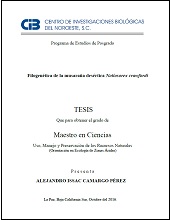Filogenética de la musaraña desértica Notiosorex crawfordi
Author
ALEJANDRO ISSAC CAMARGO PEREZ
Metadata
Show full item recordAbstract
Las musarañas desérticas del género Notiosorex incluyen a cuatro especies recientes N. cockrumi, N. crawfordi, N. evotis, N. villai y cuatro fósiles N. jacksoni, N. dalquesti, N. harrisi y N. repenningi (Carraway, 2007). Con base en la divergencia molecular existente en la especie N. crawfordi se cree que una quinta especie pudiera estar presente en la península de Baja California (PBC), pero debido al bajo número de ejemplares analizados no se ha logrado conocer si esta divergencia asociada a lo largo de su distribución (Ohdachi et al., 2006; McAliley et al., 2007). Con base en la hipótesis planteada se analizó la variación genética a nivel específico a partir de individuos de diferentes localidades en la PBC y California. A partir de salidas al campo dentro de la PBC y material de colecciones científicas se realizaron extracciones de ADN. Se utilizaron los marcadores moleculares de origen mitocondrial (Cyt b, 800 pb; COI, 542, pb, COIII, 672 pb) y un intrón del beta fibrinógeno (FGB-17 385 pb). Se reconstruyó una filogenia con las especies del genero Notiosorex, los enfoques filogenéticos utilizados fueron el de Máxima Verosimilitud (MV), Inferencia Bayesiana (IB) para corroborar la identidad molecular de las poblaciones analizadas. Se obtuvieron distancias genéticas entre 14 -16% utilizando los modelos K2P, JC y p-distance entre las poblaciones de la PBC y las poblaciones de Arizona. Los análisis de reconstrucción filogenética MV e IB realizados, muestran topologías prácticamente idénticas, ubicando a las poblaciones en tres clados monofiléticos con valores de soporte de bootstrap alto < 90%. La divergencia genética también fue alta dentro del linaje N. cockrumi entre 12.2 - 13.8% y con el género hermano Megasorex gigas de 19.3 - 20.4%, ambos pertenecientes a la tribu Notiosoricini. En base a la monofilia observada en la topología de los análisis utilizados se ha evidenciado un aislamiento genético entre las poblaciones de Notiosorex a lo largo del noroeste de su distribución. Los resultados filogenéticos obtenidos de identidad molecular entre las musarañas del genero Notiosorex sugiere una asignación taxonómica a nivel específico de las poblaciones al noroeste de su distribución. The desert shrews of the genus Notiosorex include four recent species N. cockrumi, N. crawfordi, N. evotis, N. villai, and four fossil species N. jacksoni, N. dalquesti, N. harrisi and N. repenningi (Carraway, 2007). Based on the existing molecular divergence in the species N. crawfordi, it is believed that a fifth species may be present in the Baja California Peninsula (BCP), but the low number of samples analyzed makes it difficult to know whether this divergence is associated with its distribution (Ohdachi et al., 2006; McAliley et al., 2007). Based on this hypothesis, genetic variation at species level was analyzed with individuals from different locations in the BCP and California, U.S.A. From field trips within the BCP and scientific material collections, DNA extractions were performed; molecular markers of mitochondrial origin (Cyt b, 800 pb; COI, 542 pb; COIII, 672 pb) and fibrinogen intron beta (FGB-17 385 bp) were used; a phylogeny was reconstructed with species of the genus Notiosorex; the phylogenetic approaches used were the Maximum Likelihood (ML) and Bayesian Inference (IB) to corroborate the molecular identity of the populations analyzed. Genetic distances between 14 -16% were obtained using the K2P, JC, and p-distance models among populations of the BCP and those of Arizona. The reconstruction phylogenetic analyses MV and IB showed almost identical topologies, placing populations in three monophyletic clades with high support bootstrap values < 90%. Genetic divergence was also high in N. cockrumi lineage from 12.2 - 13.8% compared with its sister genus Megasorex gigas from 19.3 - 20.4% both belonging to the tribe Notiosoricini. The monophyly observed in the topology of the analyses performed has shown a genetic isolation among Notiosorex populations along their northwestern distribution. The results of molecular phylogenetic identity among shrews of the genus Notiosorex suggest assigning a specific taxonomic level to the populations northwest of their distribution.
URI Nacional
http://cibnor.repositorioinstitucional.mx/jspui/handle/1001/220https://cibnor.repositorioinstitucional.mx/jspui/handle/1001/220
Collections
Related items
Showing items related by title, author, creator and subject.
-
PROMOCIÓN DEL PERIFITON PARA EL CULTIVO DE CAMARÓN BLANCO: HACIA UNA ACUICULTURA ECOLÓGICA
DOMENICO VOLTOLINA LOBINA; JUAN MANUEL AUDELO NARANJO; MARIA DEL ROSARIO PACHECO MARGES -
Suelo y Erosión
YOLANDA LOURDES MAYA DELGADO


